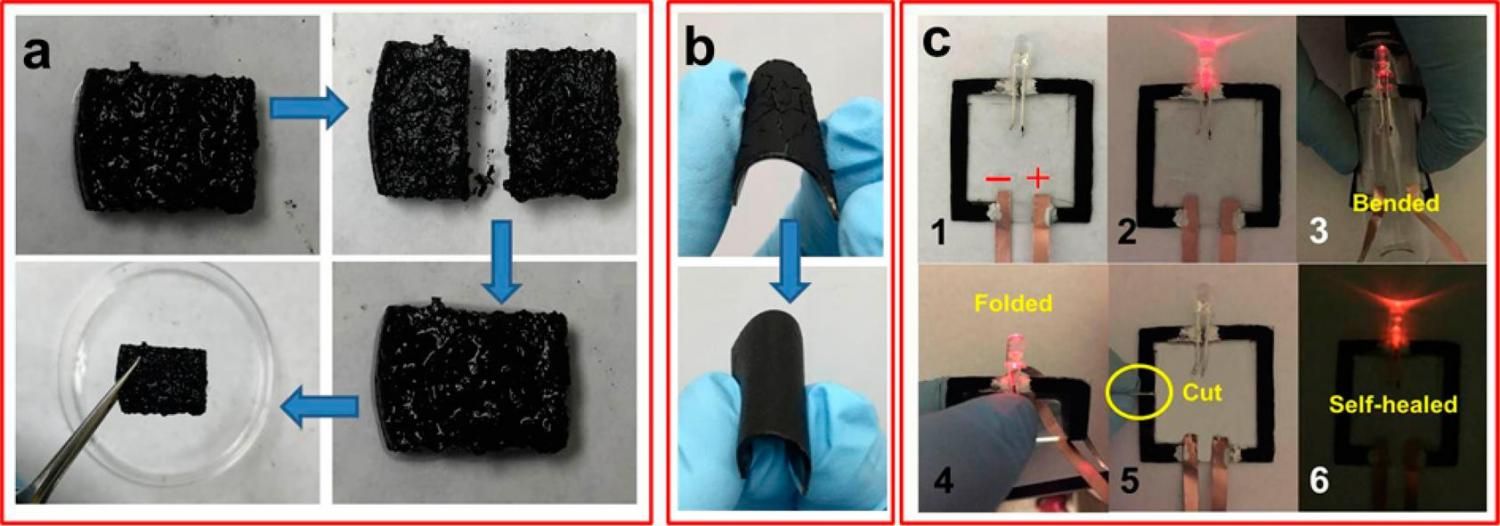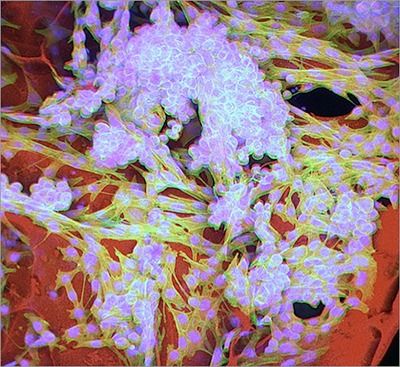Page 11792
Aug 27, 2015
Telomere dysfunction induces metabolic and mitochondrial compromise. Nature
Posted by Steve Hill in categories: biotech/medical, life extension
Dr DePinho released a paper in 2012, this builds on previous papers and his theory of the “telomere-p53-PGC axis”. This is a big reason along with the work of Dr Michael Fossel I believe telomerase therapy is probably the best chance of radical life extension in the near future. This is one of a number of papers that implicate dysfunctional telomeres in a cascade that causes mitochondrial dysfunction and various other aging consequences.
ABSTRACT Telomere dysfunction activates p53-mediated cellular growth arrest, senescence and apoptosis to drive progressive atrophy and functional decline in high-turnover tissues. The broader adverse impact of telomere dysfunction across many tissues including more quiescent systems prompted transcriptomic network analyses to identify common mechanisms operative in haematopoietic stem cells, heart and liver. These unbiased studies revealed profound repression of peroxisome proliferator-activated receptor gamma, coactivator 1 alpha and beta (PGC-1α and PGC-1β, also known as Ppargc1a and Ppargc1b, respectively) and the downstream network in mice null for either telomerase reverse transcriptase (Tert) or telomerase RNA component (Terc) genes. Consistent with PGCs as master regulators of mitochondrial physiology and metabolism, telomere dysfunction is associated with impaired mitochondrial biogenesis and function, decreased gluconeogenesis, cardiomyopathy, and increased reactive oxygen species. In the setting of telomere dysfunction, enforced Tert or PGC-1α expression or germline deletion of p53 (also known as Trp53) substantially restores PGC network expression, mitochondrial respiration, cardiac function and gluconeogenesis. We demonstrate that telomere dysfunction activates p53 which in turn binds and represses PGC-1α and PGC-1β promoters, thereby forging a direct link between telomere and mitochondrial biology. We propose that this telomere-p53-PGC axis contributes to organ and metabolic failure and to diminishing organismal fitness in the setting of telomere dysfunction.
Aug 27, 2015
Discovery of new code makes reprogramming of cancer cells possible
Posted by Alexandros El in category: biotech/medical
Cancer researchers dream of the day they can force tumor cells to morph back to the normal cells they once were. Now, researchers on Mayo Clinic’s Florida campus have discovered a way to potentially reprogram cancer cells back to normalcy.
The finding, published in Nature Cell Biology, represents “an unexpected new biology that provides the code, the software for turning off cancer,” says the study’s senior investigator, Panos Anastasiadis, Ph.D., chair of the Department of Cancer Biology on Mayo Clinic’s Florida campus.
That code was unraveled by the discovery that adhesion proteins — the glue that keeps cells together — interact with the microprocessor, a key player in the production of molecules called microRNAs (miRNAs). The miRNAs orchestrate whole cellular programs by simultaneously regulating expression of a group of genes. The investigators found that when normal cells come in contact with each other, a specific subset of miRNAs suppresses genes that promote cell growth. However, when adhesion is disrupted in cancer cells, these miRNAs are misregulated and cells grow out of control. The investigators showed, in laboratory experiments, that restoring the normal miRNA levels in cancer cells can reverse that aberrant cell growth.
Aug 27, 2015
Antimatter catches a wave: Accelerating positrons with plasma is a step toward smaller, cheaper particle colliders
Posted by Early Boykins III in categories: energy, particle physics
A study led by researchers from the U.S. Department of Energy’s (DOE) SLAC National Accelerator Laboratory and the University of California, Los Angeles has demonstrated a new, efficient way to accelerate positrons, the antimatter opposites of electrons. The method may help boost the energy and shrink the size of future linear particle colliders — powerful accelerators that could be used to unravel the properties of nature’s fundamental building blocks.
The scientists had previously shown that boosting the energy of charged particles by having them “surf” a wave of ionized gas, or plasma, works well for electrons. While this method by itself could lead to smaller accelerators, electrons are only half the equation for future colliders. Now the researchers have hit another milestone by applying the technique to positrons at SLAC’s Facility for Advanced Accelerator Experimental Tests (FACET), a DOE Office of Science User Facility.
“Together with our previous achievement, the new study is a very important step toward making smaller, less expensive next-generation electron-positron colliders,” said SLAC’s Mark Hogan, co-author of the study published today in Nature. “FACET is the only place in the world where we can accelerate positrons and electrons with this method.”
Aug 27, 2015
Electrical circuit made of gel can repair itself
Posted by Early Boykins III in categories: electronics, energy, materials, robotics/AI
(Phys.org)—Scientists have fabricated a flexible electrical circuit that, when cut into two pieces, can repair itself and fully restore its original conductivity. The circuit is made of a new gel that possesses a combination of properties that are not typically seen together: high conductivity, flexibility, and room-temperature self-healing. The gel could potentially offer self-healing for a variety of applications, including flexible electronics, soft robotics, artificial skins, biomimetic prostheses, and energy storage devices.
The researchers, led by Guihua Yu, an assistant professor at the University of Texas at Austin, have published a paper on the new self-healing gel in a recent issue of Nano Letters.
The new gel’s properties arise from its hybrid composition of two gels: a supramolecular gel, or ‘supergel’, is injected into a conductive polymer hydrogel matrix. As the researchers explain, this “guest-to-host” strategy allows the chemical and physical features of each component to be combined.
Aug 27, 2015
Anti-cancer vaccine uses patient’s own cancer cells to trigger immune responses
Posted by Sean Brazell in categories: biotech/medical, genetics
Cancerous melanoma cells, shown with their cell bodies (green) and nuclei (blue), are nestled in tiny hollow lumens (tubes) within the cryogel (red) structure. (credits: Thomas Ferrante, Sidi A. Bencherif / Wyss Institute at Harvard University)
A new biologically inspired “injectable cryogel whole-cell cancer vaccine” combines patient-specific harvested cancer cells and immune-stimulating chemicals or biological molecules to help the body attack cancer. It has been developed by scientists at Harvard’s Wyss Institute and Dana-Farber Cancer Institute.
This new approach is simpler and more economical than other cancer cell transplantation therapies, which harvest tumor cells and then genetically engineer them to trigger immune responses once they are transplanted back into the patient’s body, the researchers say.
Continue reading “Anti-cancer vaccine uses patient’s own cancer cells to trigger immune responses” »
Aug 27, 2015
Political polarization on Twitter depends on the issue | Phys.org
Posted by Odette Bohr Dienel in category: media & arts
““To some extent, social media platforms can promote democratic deliberation and the exchange of ideas from different perspectives,” says Barberá. “Even for the most divisive topics, such as the 2012 presidential election, we did not see a perfect division on Twitter — while people may encounter political views that they agree with, they’ll encounter divergent opinions as well.””
Tag: Twitter
Aug 27, 2015
PGC-1α Modulates Telomere Function and DNA Damage in Protecting against Aging-Related Chronic Diseases
Posted by Steve Hill in categories: biotech/medical, life extension
An interesting paper that uses ALA to shore up telomerase activity, loss of telomeres inhibition of P53 expression and mitochondrial dysfunction in one go. They use ALA (alpha lipoic acid) to induce PGC-1α in this case though PGC1-alpha seems to be a potential target for intervention as I understand that ALA is difficult to deliver to cells. In this case this involves the vascular system and atherosclerosis.
http://www.cell.com/cell-reports/abstract/S2211-1247(15)00825-6
Short telomeres and Mitochondrial dysfunction are increasingly implicated as being closely linked as this 2012 Dephino paper demonstrates in the aging heart:
LISTENING, the award-winning debut feature from visionary director Khalil Sullins, is a psychological thriller about penniless grad students who invent mind-reading technology that destroys their lives. David, Ryan, and Jordan hope the telepathy invention will solve all their problems, but the bleeding-edge technology opens a Pandora’s box of new dangers, as the team discovers that when they open their minds, there is nowhere to hide their thoughts. Secrets and betrayals surface, and the technology is stolen by a covert government agency with a hidden agenda. With no one left to trust, David is forced against his friends in a life-or-death battle over not only the privacy of the human mind, but the future of free will itself.
Aug 26, 2015
The 2015 Fuller Challenge Semi-Finalists | The Buckminster Fuller Institute
Posted by Odette Bohr Dienel in categories: climatology, education, science, sustainability, water
“Now in its 8th annual cycle with the strongest applicant pool yet, including the most diverse pool of program entrants to date creating change in 136 countries, The Fuller Challenge remains the only award specifically working to identify and catalyze individuals and teams employing a whole systems approach to problem solving.”
















